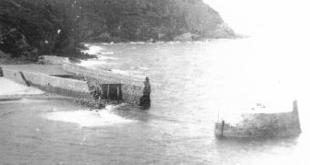Location:
Alrick Building, Classroom 10
Date:
Presenter: Prof. William Allsop
- Technical Director, Maritime Structures HR Wallingford
- Visiting Professor, University of Southampton
- PhD student, University of Edinburgh
Orphan Breakwaters - how do they fail, and what protection might they offer when they collapse?
Abstract
There is a long tradition in the UK of coastal towns / villages or country estates constructing their own harbours for trade and/or fishing, particularly on 'rocky' coastlines where the topography / geology hindered construction of roads or railways. In the expansion of harbour construction around 1770-1880, many such harbours were sheltered from wave action by a breakwater (or multiple breakwaters) protecting quays, cargo handling facilities, and storage areas. Some failed very early (e.g. Port Logan, Greve du Lecq). Some survive to the present, and remain important to the harbours. But for many such harbours, maritime incomes have reduced, or disappeared, leaving the harbour with no income for maintaining / repairing breakwaters.
Now if the only beneficiaries of wave protection were the original operations, these changes might have little consequence. But, since original construction, areas around the harbours have been increasingly adopted for commercial and/or residential purposes. These derive significant wave shelter from the now orphaned breakwater.
The most common construction until late 1800s used stone blockwork founded on rubble mounds, later concrete blocks, with random rubble (or sand) infill. What happens when those orphan breakwaters collapse, reducing or removing protection from direct wave action? Some wave reduction will still be afforded by the collapsed structure, but how much? The presentation will conclude with early results from recent model studies (but no formulae!) to quantify protection after such failures.
Biography
William Allsop is Technical Director for Maritime Structures at HR Wallingford (part-time), responsible for consultancy and research studies, design of breakwaters, sea walls, revetments, and wide range of shoreline and related structures.
He has more than 40 years in design and construction of breakwaters (rubble mound, vertical and composite), sea walls, revetments, piers / jetties and coastal / shoreline structures. He has supervised testing in UK, Italy, Netherlands, Germany, Spain, Denmark, France, Turkey and Nigeria. Recent studies have included work on major LNG terminals in the Pacific and Atlantic, the Turner Gallery at Margate, and advising US government on coastal bridges damaged by hurricanes. He has a long-term interest in historic breakwaters around the UK, particularly at Alderney, Arbroath, Peterhead, Portpatrick, Plymouth, St Andrews and Wick, now cemented by his PhD studies at Edinburgh.
William Allsop is a Visiting Professor at Southampton. He recently completed service as Chairman of ICE Breakwaters Conference, ICE Maritime Board and ICE Maritime Engineering Journal panel. He was appointed an Honorary Professor at University College London in 2014.





